Koorda Native Flora Reserve mini-review
Yay, we are allowed to drive in the Wheatbelt Region of WA! I
went for a trip into the Wheatbelt and as it was too far for a
comfortable one-day trip, looked for somewhere to park overnight. I used
Google, typed in "campsites near Koorda" and got a few hits, including
the Koorda Native Flora Reserve.
Koorda is a small town, about two hours drive from Perth:
https://en.wikipedia.org/wiki/Koorda,_Western_Australia
Google Maps also recognised the reserve and was able to direct me
there. It is about 14km from Koorda. Had a Telstra signal all the way
and also at the site. There is a sign at the entrance:

A narrow track to get in, but a big open area to turn around at the
"picnic area" if you have a caravan. Nice facilities, a covered table:

Also, there are a couple of fire pits and a toilet. The toilet is on
the horizon in the above photo, and needs special mention, as it is very
clean and well maintained:
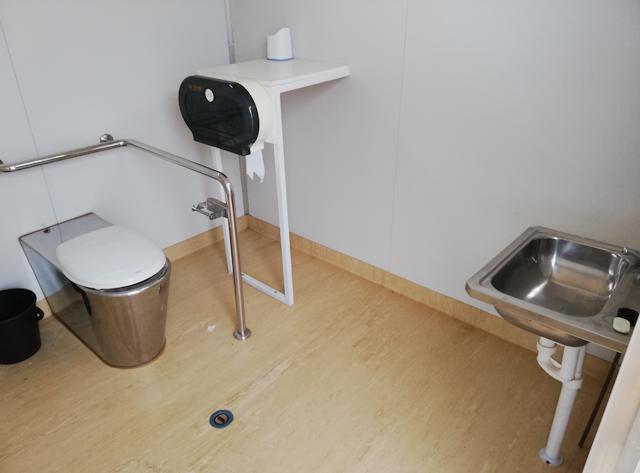
...there is even soap on the basin!
A big plus point is that it is free. But I do like to give something back, and buy petrol and food in the local town.
Any negatives? Well, yes, the flies. These are annoying little
critters, that try and get into the eyes. These "bush flies" are
prevalent throughout the northern Wheatbelt and further north and
inland. Just have to put up with them. As the evening gets cooler, they
reduce. There is really only 2-3 months from mid-winter when they are
very reduced during the day.
Anyway, apart from that pet peeve, it is a nice little spot, well worth an overnight stay if you are going that way. More links:
https://www.aircamp.com.au/campsite/koorda-native-flora-reserve
https://www.wheatbeltway.com.au/towns/?act=Koorda
Tags: nomad
Ganga Mill Campground mini-review
Here in Western Australia, we have restrictions where we can
drive. As I live in Perth, I am only allowed to go camping in the
Perth-Peel Regions. Though, from Monday 18th May, this will be eased and
driving will be allowed to the Wheatbelt, South West and Great Southern
Regions. That is good, but most of the grey nomads would prefer to be
able to drive north, toward warmer climate.
I checked out what DPAW campgrounds are in the Perth-Peel Regions,
and also don't require pre-booking. Not much choice, in fact, no choice,
only Nanga Mill and Nanga Townsite campgrounds are
first-come-first-served, no booking. So, decided to get away for a
couple of days.
If you live in Perth and just want a quick get-away for the weekend,
it is a good choice, only about 1 hour and 30 minutes drive. You drive
south from Perth, on the South Western Highway, through Byford, then
before Pinjarra there is a turn-off to the left, to Dwellingup. Arrive
Dwellingup, turn left at main street t-junction, go out of town, and
Nanga Road is on the right.
Here is the DPAW page:
https://parks.dpaw.wa.gov.au/site/nanga-mill
Concession price is AU$8 one-time entry fee per car, and AU$7 per night, per person.
I have to admit, these days I prefer coastal camping, just find the
ocean, beaches, etc., so much more interesting. But, thick bushland,
tall trees, do have some attraction.
Tall trees, yes, nestled in a valley beside a stream -- very nice,
but a problem for my solar panel. I chose the sunniest spot, and got sun
from about 9.00am to 2.30pm -- either side of those times the sun was
partly obscured by trees. Winter here, so the sunshine hours will be
more in the other three seasons.
This is my camping spot, I am on the right:
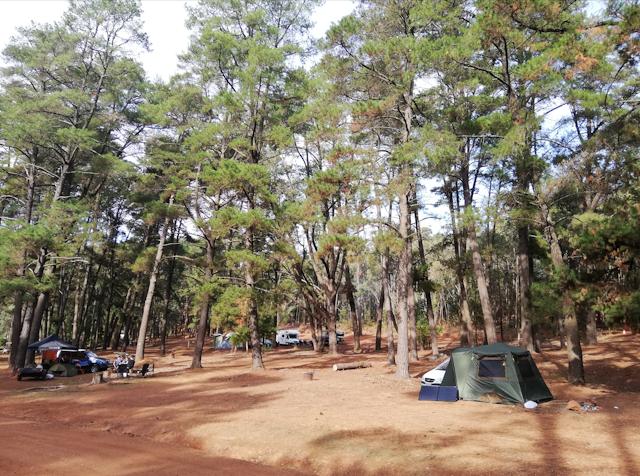
...doesn't look like many people camping there, but there were, lots
of people, spread along the stream bank. Most of them were in more
thickly-treed spots then mine.
It was interesting to observe the type of people there. More of the
city get-away-for-a-few-days crowd, than holidayers and grey nomads.
Consequently, some of the groups were "living it up" a bit more than I
am accustomed to.
The group next to me, on left in above photo, had a radio running
from arrival until late at night. On the other side, a fellow played
"bongo drums".
The campsite does not have a camp kitchen, but does have open-air gas
barbecues and fire pits. Many groups availed themselves of the latter,
and there was a pall of smoke thoughout the campsite in the evening. I
don't mind smoke though. Here is one of the barbecues and one of the
bigger firepits:
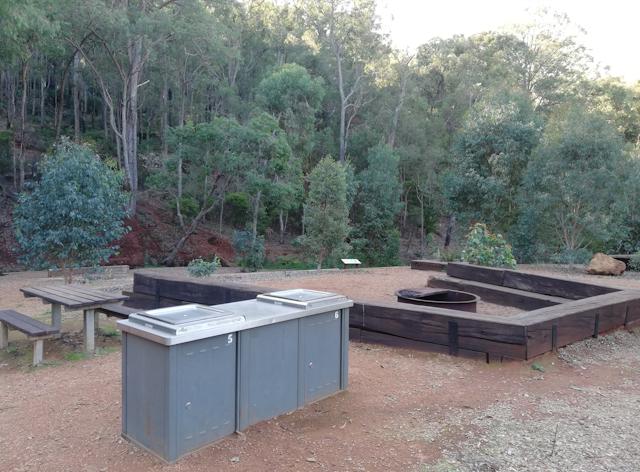
...the gas is free.
The campsite runs along a stream, which was no more than about 12 inches deep at the deepest, so paddling only:
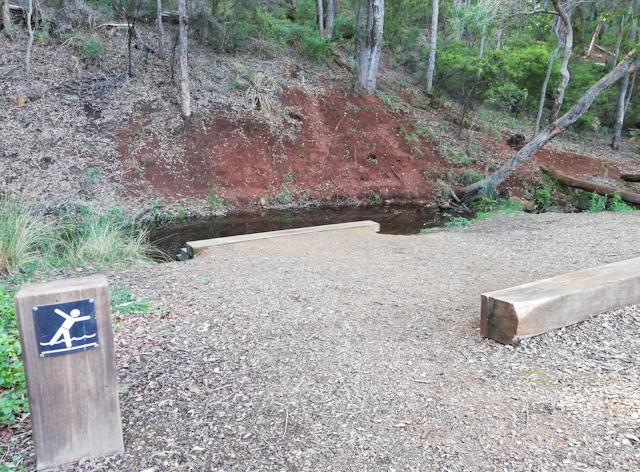
I didn't see them, but apparently some of the nearby campsites have places where you can swim.
So, what is there to do, apart from paddling in the stream? There are walking trails, various lengths, up to an 18km loop.
So, thumbs-up or thumbs-down? Personally, I would have preferred a
covered kitchen area, and gas-ring stove would have been nice. I spotted
one tap, with non-potable water. There are toilets, the deep-drop kind,
and they were clean and didn't smell.
You have to bring your own wood, and bags are available in Dwellingup
for $10. I have been to DPAW campsites that have wood available for
free.
No phone signal, though there is a notice that Telstra intends to put
a tower there. Radio reception on AM band had a lot of background hiss
and only one station, 558KHz, was listenable. Nothing on FM.
Yeah, overall OK. Depends what you want. A weekend get-away with your
friends, then ticks the boxes. As a stop-over as you do the "big
lap" around Australia, ticks the boxes also. After a few days, most
people would be bored and would want to move on, I reckon -- but then,
everyone is different, and some might like an extended stay, just going
for long walks. Here is some feedback at TripAdvisor:
...some of the other campsites, that require pre-booking, within Lane Pool Reserve look very interesting.
Tags: nomad
Coulometer error creep
I posted about installation and calibration of the coulometer, that displays battery state-of-charge (SoC):
https://bkhome.org/news/202004/installation-of-the-coulometer-lcd-display.html
I used the Amptron 15A LifePO4 mains-input battery charger to charge
the battery to 100%, then set the coulometer to 100% and capacity 50AH.
There is however, a problem: a battery charge/discharge cycle is not
100% efficient, there is some loss as heat. The battery may be capable
of supplying 50AH, however, it will require more than 50AH to charge it
fully from empty.
Lead-acid technology battery are very inefficient, only about 70-80%
efficient in the discharge/recharge cycle. LiFePO4 batteries are much
more efficient, 90-92% round trip, see this document:
https://www.victronenergy.com/upload/documents/Datasheet-BMS-12-200-EN.pdf
The problem is that the heat loss is going to mean the coulometer
will read incorrectly, becoming more incorrect with each
discharge/recharge cycle. This is what will happen if we start with a coulometer
reading of 100%, discharge to a reading of 20% SoC, then charge back up
to a reading of 100%, then down to a reading of 20%, and so on:

...this is showing the actual battery capacity (the values
given are for illustration only). After some charge and discharge cycles,
when the coulometer drops to reading 20%, the battery will actually
have reached 0%.
This is bad news, however, the coulometer will self-correct every
time the battery is charged to full. For example, I plugged in the
Amptron mains-input LiFePO4 12V 15A charger, and plotted voltage,
current and state-of-charge (latter as read by the coulometer):

The coulometer has reached a reading
of 100% before the mains charger has finished charging. As you can see
above, the coulometer is reading 100% at 29 minutes, and the charger
keeps going and turned itself off at about 31.5 minutes.
Note, after about a minute, the charger turned back on momentarily,
then did so again after about another minute. I didn't catch the
voltage/current readings, it was a very short duration.
Reaching 100% reading on the coulometer before the charging completes
is a correction mechanism, however, a problem is that this
self-correction is only going to happen if the battery is charged to
full, or nearly full.
We really need another mechanism for the coulometer to self-correct. I
don't see how we can use the charging voltage, however, the coulometer
could be set to read 0% if the battery voltage drops below a certain
value. This web page is a good read, and has some information on
discharge voltage:
https://www.solacity.com/how-to-keep-lifepo4-lithium-ion-batteries-happy/
...that link has a graph of battery voltage while discharging, though
it must be recognized that this is dependent on the discharge current.
The graph is reproduced here:
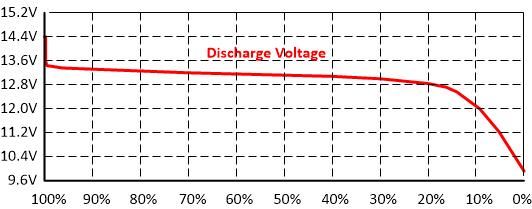
The Battery Management System (BMS) built-in to the battery will
automatically disconnect the output if the voltage falls below a certain
value -- from a bit of reading, this seems to be in the range of 2.5 to
2.8 volts per cell, which will be 10.0 to 11.2 volts for a 12 volt
battery.
My Amptron 50AH battery has a BMS that turns the battery off at 10.0 volts.
The coulometer setup allows entry of a minimum voltage, below which
the % charge will immediately drop to 0%. So, how about 11.2V?
OK, I have done that, have programmed 11.2V as the 0% limit in the
coulometer. This will give an automatic correction when discharging the
battery. The battery will be down at around 5% actual charge to trigger
this.
Discharging a LifePO4 battery to 5% SoC will reduce the lifetime, but
this should be a correction factor that is only triggered occasionally.
Hopefully. Even if it is triggered often, I will still expect to
get about 2,000 cycles, and even if I cycle the battery every day, it is
going to last several years.
One more point to make about coulometer setup: does a battery rated
at "50AH" actually deliver 50AH? If not, then the capacity entry in the
coulometer will have to be adjusted accordingly.
It should be noted that the "error creep" that I have reported in this post is a known problem, and it occurs on many devices, such as mobile phones and electric scooters.
Tags: nomad
Powerbox front-page in nomad section
I have created a front-page for the lithium powerbox project, in the "nomad" section of my website:
https://bkhome.org/nomad/barrys-lithium-powerbox.html
The nomad section is a gradual accumulation of documents for and
about "nomads", especially "grey nomads" -- these are people who have
chosen an alternative lifestyle on-the-road, periodically or permanent.
Here is the front-page to the "nomad" section:
Ha ha, I am in lockdown, as are all the grey nomads in Australia, but restrictions are easing.
Tags: nomad
Powerbox circuit diagram updated
As the "protected +bus" has been added, and the binding-posts are
not shown in the original circuit diagram, I have updated the diagram:
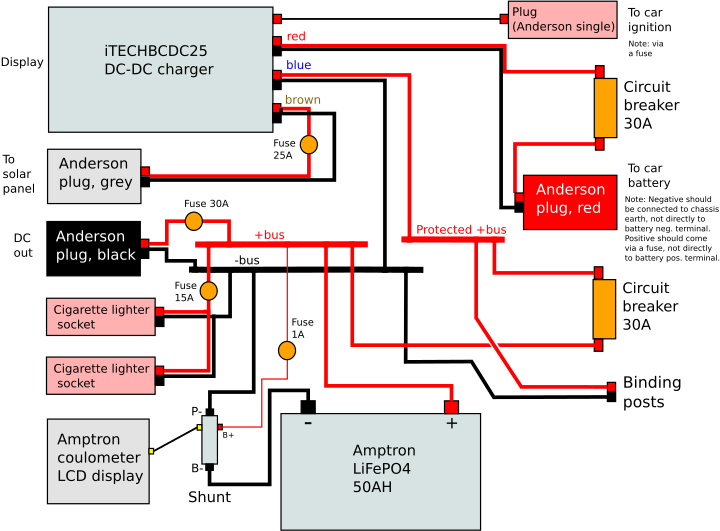
The earlier blog post has been edited and the latest Dia and SVG files posted:
https://bkhome.org/news/202004/powerbox-fuse-redesign.html
Tags: nomad
Lithium powerbox photo-shoot
The powerbox is complete, for now anyway. There have been a
series of blog posts as the project progressed, and the intention is to
create a front-page for the project, that will link to all of the blog
posts, in the correct sequence for anyone who wants to build one.
Here is the previous post:
https://bkhome.org/news/202005/itechbcdc25-dc-dc-charger-problem-resolved.html
There were some refinements to improve battery-terminal accessibility
and wiring-board layout, and I edited the second-from-last post:
https://bkhome.org/news/202004/dc-dc-charger-issues-and-powerbox-improvements.html
Now for a photo-shoot, with the powerbox posing at various angles for the camera:




Need to do some more testing of course, and go camping!
Tags: nomad
iTECHBCDC25 DC-DC charger problem resolved
In the last post in the lithium powerbox project, I reported a couple of issues with the DC-DC charger:
https://bkhome.org/news/202004/dc-dc-charger-issues-and-powerbox-improvements.html
I sent an email to iTECHWORLD Service department, reporting two problems:
- The battery-type selector button did not work, it was stuck on "calcium"
- The MPPT regulator was not tracking at the peak power point of the panel
I received a reply from Jason, that has resolved the first issue, number-2 is looked at a bit more today.
Before receiving the reply from Jason, early this morning I thought
it necessary to perform a more thorough test of the DC-DC charger, solar
charging...
Nice sunny day today, last chance as rain forecast over the next
several days. In fact, almost exactly one year ago, on an almost
identical day, mid-winter, sunny, hardly any breeze, ambient 16 degC, I
tested three solar panels, including the Atem Power "250W" panel:
https://bkhome.org/news/201905/measurements-for-three-solar-panels.html
...and recorded a peak power output for the Atem Power panel of 157.2W.
MPPT charging
Early this morning, Friday 1st May, 2020, 9.10am - 9.30am, have
tested charging the iTECHBCDC25 with this same panel. Ambient is 17
degC, irradiance is 820W/m2 -- a year ago it was almost the same,
800W/m2.
As the DC-DC charger is stuck on "calcium" battery type, I used my
Waeco Coolpower 44 battery box, which has a deep cycle 44AH AGM battery,
a closer choice to the calcium charging profile than the lithium
battery. Here is a photo:
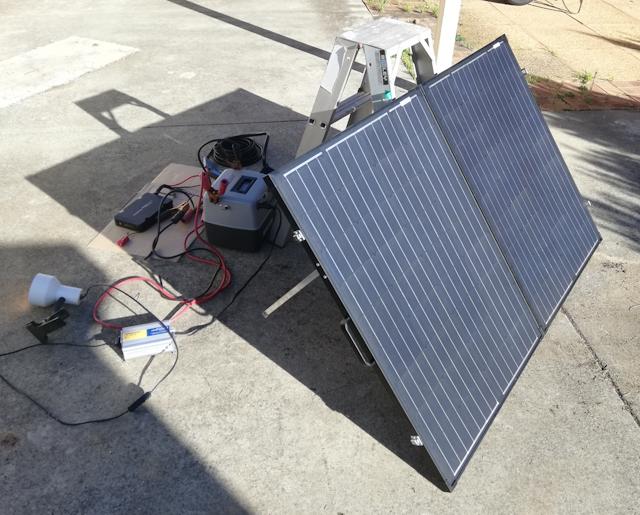
As the battery is fully charged, I loaded it down by a 40W globe
running via an inverter. The panel was outputting 20.3V at 4.99A (101W),
and the battery voltage was 14.7V.
I needed to load the battery down a bit more, bring down the battery
voltage, so that the DC-DC charger will think the battery
state-of-charge is low, and will then pull everything it can from the
panel. So I attached my air compressor. Now getting 15.4V at 9.6A (148W) from the panel, battery voltage 12.1V.
Good, but a year ago, I determined the peak power point of the panel to be 16.21V, power output of 157W. So that issue is still there, the iTECHBCDC25 is pulling at a bit off the peak power point.
But, to be 100% certain about this, I really should test for the peak power point at the same time as testing with iTECHBCDC25.
Battery-type
Moving on, the issue of the battery-type button being stuck on "calcium". Here is a photo:

Fast forward to this evening, I read my emails, and here is the reply from Jason:
...riiiight. Tonight, I used the Waeco Coolpower as the "car
battery", connected to the red and black cable of the iTECHBCDC25, and
hey, was able to change to "Lithium" type. Good, but the User Manual
does not state that the "car battery" only has to be connected. Quoting
from the User Manual:
SOLAR INPUT
Once correctly installed, the iTECHBCDC25 has MPPT solar
charging for increased solar efficiency.
Once your solar panel has been connected to the solar
input section of the iTECHBCDC25 the charger will
transfer to solar mode when the vehicle is not running.
The initial default setting is for AGM/GEL batteries.
If you are charging a battery of a different chemistry
simply change the battery type by pressing the battery
type selector button on the front panel of the
iTECHBCDC25.
Once you have selected the new battery type the
iTECHBCDC25 will remain on this battery type until it is
changed.
Solar charging requires a solar input of 16 to 25v.
Your solar panel will need to be unregulated when
connecting to the iTECHBCDC25.
Well, that is a relief, the charger is not broken.
Tags: nomad
DC-DC charger issues and powerbox improvements
Ha ha, I am an inveterate tinkerer -- in the sense of always
wanting to experiment, modify and improve whatever I have designed and
constructed. In fact, the journey is often as much or more fun than the
destination. Camping, for example -- preparing for camping is as much
fun as actually going camping.
Nice sunny day, so this morning took the powerbox outside and
connected the Atem Power "250W" solar panel. Yes, it does charge, but
there are two serious issues. I have sent an email to iTECHWORLD
technical support, and will await their response before deciding if
these "issues" can be described as faults. Stay tuned for developments.
The previous blog post for this powerbox project:
https://bkhome.org/news/202004/installation-of-the-coulometer-lcd-display.html
In earlier posts, I have identified some limitations in the physical
design of the powerbox and the wiring layout. Decided to fix them,,,
Getting at those battery terminals is just too awkward and dangerous.
The top-plate of the box is screwed on from the underneath. In
retrospect, this was dumb, but there was a reason originally -- wanted
to place the DC-DC charger flat on the top of the box, without
protruding screws getting in the way.
Screwing from the top allows the screws to be removed and top panel
lifted off. This allows access to the battery terminals. So, I pulled
off all of the side panels, removed the screws holding on the top panel:

...yay, easy access to the battery terminals. You can't see the
positive terminal in the photo, as it is covered with black electrical
tape.
Late night right now, tomorrow will apply screws from the top. It
will be easy to remove them and lift up the top panel any time it is
desired to access the battery terminals, or anything else.
Another problem is that extra terminal block just floating there, looking messy, see this earlier snapshot:
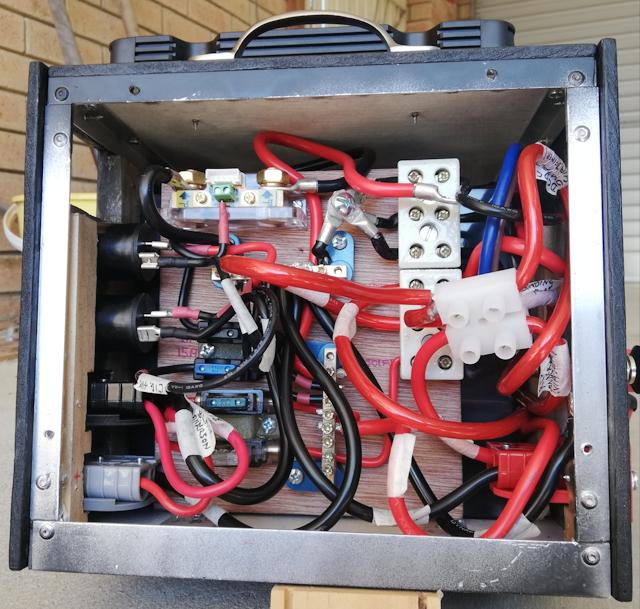
Another task for tomorrow will be replacement of that floating
terminal block with a small busbar mounted on the spare space on the
wiring-board. And a bit of a tidy-up of the wiring.
EDIT 2020-05-02:
The top plate has been modified, with screws on the top, so that it can be opened up. I have edited the original blog post:
https://bkhome.org/news/202004/top-plate-of-lithium-powerbox.html
To get rid of that floating terminal block, I
have installed "protected +bus", using one of the 8-way busbars from
Jaycar, though (currently) only need three ways:
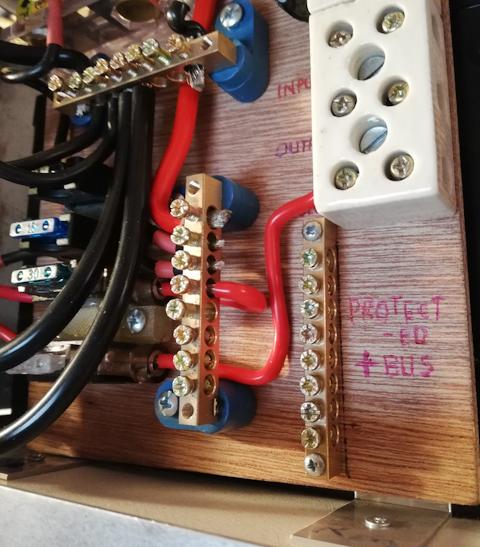
"+bus" is connected directly to the battery
positive terminal, whereas "protected +bus" is on the other side of a
30A circuit breaker. Or rather, is, once it is wired up:

And, after screwing the front and back panels into place:
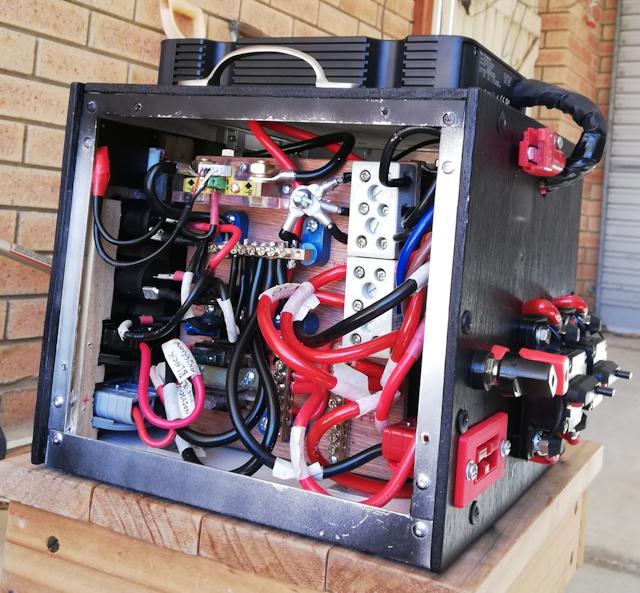
That is better. It is still crowded of course, but that was part of the exercise, to build a very compact powerbox.
Tags: nomad
